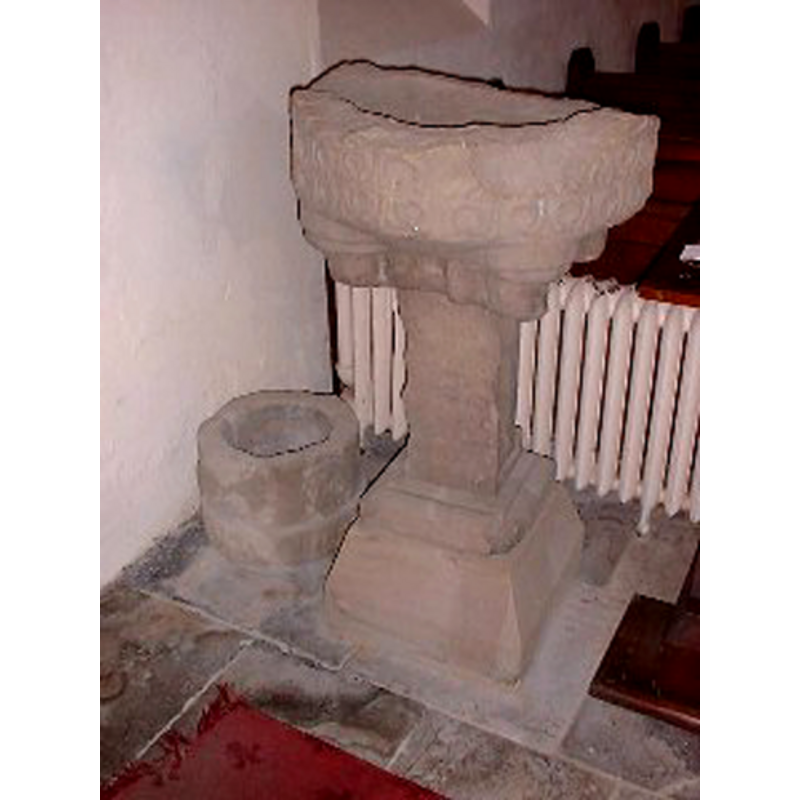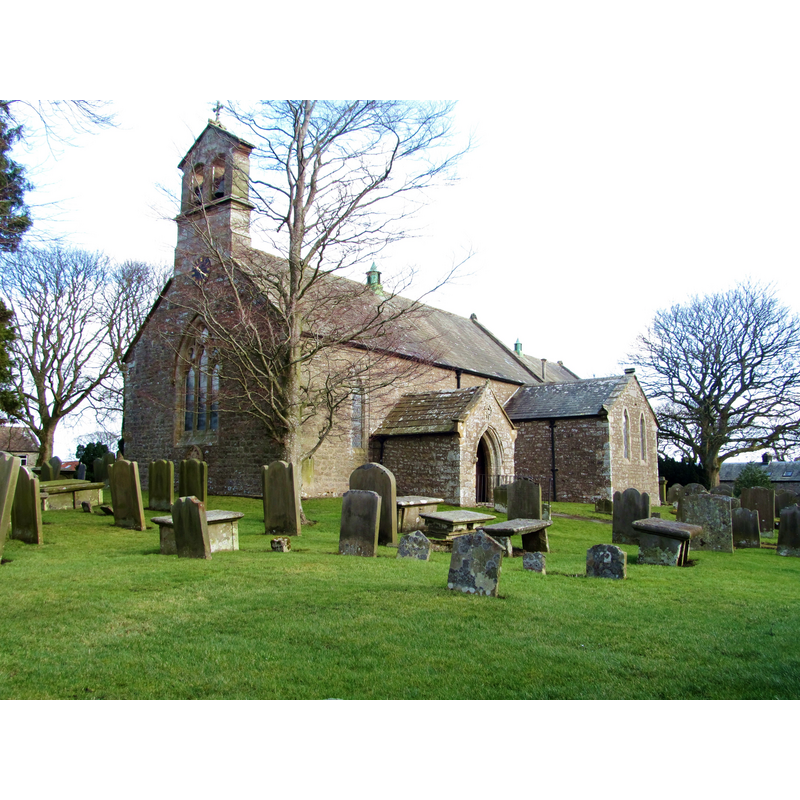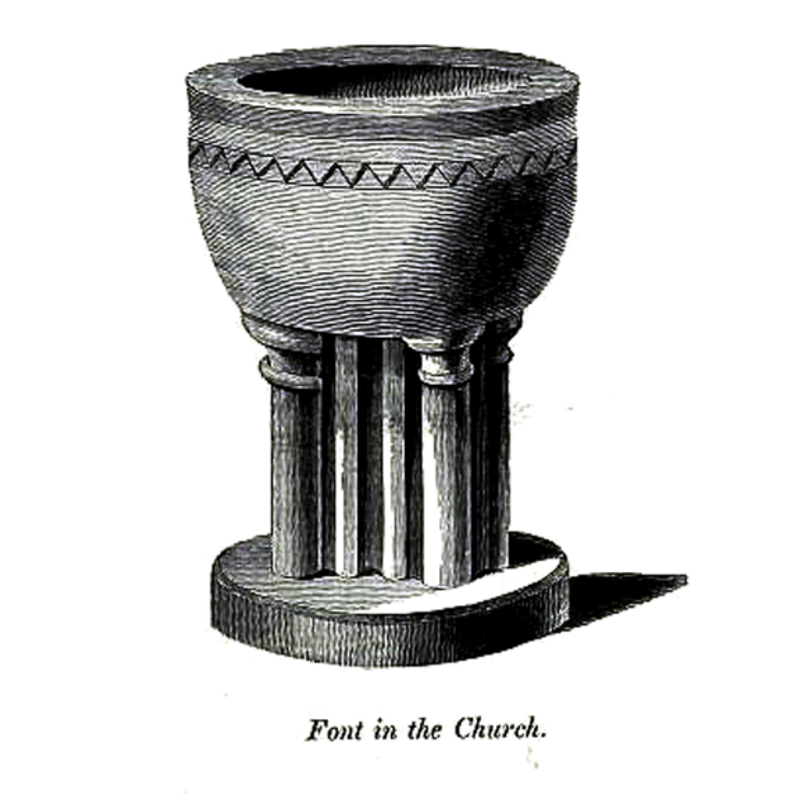Bowes No. 1 / Boghes / Bogis / Bouas / Boues / Bouexe / Boughes / Bouys

Image copyright © Richard Turner and the Bowes Parish Church, 2005
Permission received (e-mail of 2 October 2005)
Results: 5 records
design element - architectural - column
Scene Description: below the underbowl are the stumps of a central shaft and four attached colonnettes that must have formed the original base
Copyright Statement: Image copyright © Richard Turner and the Bowes Parish Church, 2005
Image Source: Digital image from www.bowes.org.uk/stgiles/
Copyright Instructions: Permission received (e-mail of 2 October 2005)
design element - patterns - floral
Scene Description: the pattern appears to be made of small roundels and covers all of the remaining surface of the basin sides
Copyright Statement: Image copyright © Richard Turner and the Bowes Parish Church, 2005
Image Source: Digital image from www.bowes.org.uk/stgiles/
Copyright Instructions: Permission received (e-mail of 2 October 2005)
view of church exterior - southeast view
view of font
INFORMATION
FontID: 01955BOW
Object Type: Baptismal Font1
Church/Chapel: Parish Church of St. Giles
Church Patron Saints: St. Giles [aka Aegidus, Egidus, Gilles]
Church Location: The Street, Bowes, Barnard Castle DL12 9LD, UK
Country Name: England
Location: Durham, North East
Directions to Site: Located at the junction of the A67-A66, 4-5 km SW of Barnard Castle, 25-27 km W of Darlington
Ecclesiastic Region: Diocese of Leeds
Historical Region: formerly North Riding of Yorkshire
Font Location in Church: For some time used as tombstone in the churchyard; later buried there. later still brought back in the church
Century and Period: 10th - 13th century, Medieval / composite
Cognate Fonts: The font at Romaldkirk, in the same Riding, has similar ornamentation
Credit and Acknowledgements: We are grateful to Richard Turner and the Parish of Bowes St Giles for the photograph of this font.
Font Notes:
Click to view
No individual entry found for Bowes in the Domesday survey. A font here is illustrated in Whitaker (1823). Gough (1792) reports a baptismal font "round on three pillars" here. Bulmer's Directory of North Yorkshire (1890) mentions "a Saxon font, upon the shaft of a Roman altar" in this locality, as well as the Norman font in use [cf. Index entry for Bowes No. 2]. Bulmer continues: "This font [i.e., the Saxon font] indicates the existence of an earlier church than the present Norman one. After being superseded by the font new in use in the 12th century, it was placed upon the shaft of a Roman altar and converted into a tombstone. It lay buried for a century or two in the churchyard, but was unearthed a few years ago, and placed upon a new pedestal." [source: www.genuki.org.uk]. Described in Cox & Harvey (1907): "an old font supported by a Roman altar, which seems to have good claim to be considered Saxon". The Victoria County History (York North Riding, vol. 1, 1914) entry for Romalkirk remarks on the similarity of the decoration on these two fonts. The VCH (ibid.) entry for Bowes has: "The church of BOWES was granted with half a carucate of land in Bowes to the Hospital of St. Peter (afterwards called St. Leonard's Hospital) at York by Stephen Count of Britanny, who died in 1137, [...] and Alan his son, and confirmed to that house by Theobald Archbishop of Canterbury [...] (1139–62). [...] At the close of the 12th century the church was within the castle wall, [...] held as a free chapel by the Crown as the owner of the castle. [...] In the church are two fonts; the one in use has a round 12th-century bowl, altered and adapted to its present stem; round the upper edge is a band of incised zigzag ornament, and at the base are capitals fitting the engaged shafts of the stem. They are bell-shaped with rolls above and below. The stem, which has engaged shafts at the four angles and three hollows on each face, seems to belong to the second font, which now consists of a bowl only, set on a 17th-century gravestone, which does duty for a stem. The bowl is 13th-century work, with two bands of leaf-work like the Romaldkirk font." Morris (1931) writes: "On either side of N door are two fonts of great interest. The first, to the W, consists of a circular, 12th-cent. bowl, on a stem that has probably belonged originally to the second. The second has a 13th-cent. circular, much broken bowl, with a pattern like that at Romaldkirk. It is now supported on a stem, with illegible inscription, that is variously described as a Roman altar [Morris here cross-references to Cox' work], and 'a 17th-cent. gravestone'!" [Morris footnote informs that Cox, but not Collingwood, "considers this bowl pre-Conquest"]. Pevsner (1985) notes: "Fonts. One plain, Norman, with some incised zigzag, on five early C13 supports. The other early C13, with a band of two tiers of tiny leaves (cf. Romaldkirk). To it belongs the stem of the first." [NB: note that Pevsner does not mention the Roman altar as part of the fonts but, rather, as a separate monument "in the N transept". Listed in Stocker (1997: 25) as one of a group of "Roman altars incorporated into fonts". The entry for this church in Historic England [Listing NGR: NY9929113514] notes: "Parish church. Mid C12 nave; C13 chancel; C14 north and south transepts; c.1404 south porch. Extensively restored and north porch added in 1863 [...] 2 fonts flanking north door: C12 circular bowl with incised zig-zag on C13 stem with 4 engaged shafts; this stem probably belonged to the other font, a C13 circular bowl with 3 bands of leafwork, which now stands upon a re-cut fragment of a Roman altar. Small, possibly C17 circular bowl, with small relief of a human figure and raised geometric decoration, to east of north door." [cf. Index entry for Bowes No. 2 for a second font listed for this church]
COORDINATES
Church Latitude & Longitude Decimal: 54.5169, -2.0124
Church Latitude & Longitude DMS: 54° 31' 0" N, 2° 0' 44" W
MEDIUM AND MEASUREMENTS
Material: stone, type unknown
Font Shape: round (mounted)
Basin Interior Shape: round
Basin Exterior Shape: round
REFERENCES
Victoria County History [online], University of London, 1993-. Accessed: 2008-11-17 00:00:00. URL: https://www.british-history.ac.uk.
Victoria County History [online], University of London, 1993-. Accessed: 2008-11-17 00:00:00. URL: https://www.british-history.ac.uk.
Betjeman, John, An American's Guide to English Parish Churches (including the Isle of Man), New York: McDowell, Obolensky, 1958
Bulmer, T., History, Topography, and Directory of North Yorkshire, Comprising its Ancient and Modern History; [...], Preston: T. Bulmer & Co. (T. Snape & Co. Printers), 1890
Cox, John Charles, English Church Furniture, New York: E.P. Dutton & Co., 1907
Gough, Richard, "Description of the old font in the Church of East Meon, Hampshire, 1789: with some observations on fonts", X, Archaeologia, 1792, pp. 183-209; p. 189
López, Miguel, "Simbolismo prerrománico: estudio sobre la pila bautismal de Guardo", [s.d.; 2005?], pp. 1-17; vol. 1: 191
Morris, Joseph Ernest, The North Riding of Yorkshire, London: Methuen & Co., 1931
Pevsner, Nikolaus, Yorkshire: the North Riding, Harmondsworth: Penguin Books, 1985 c1966
Stocker, D.A., "Fons et origo: The Symbolic Death and Resurrection of English Font Stones", I (1997b), Church Archaeology, 1997, pp. 17-25; p. 25

